Read Ancient Aliens on the Moon Online
Authors: Mike Bara
Ancient Aliens on the Moon (31 page)
The accompanying object, the “Geo-dome” also displays comparably peculiar characteristics. Roughly hexagonal in shape, it too seems to jut from the hillside as if it were the tip of a much larger sub surface object or was actually “dug in” to the side of the hill. It as well has an apparent overhanging roof with an exposed, flat-faced front “wall” facing out to the crater. It also has “windows” similar to the Chalet and a possible entrance at the base. It is set apart from the background by the brightness of the roof and its geodesic shape, similar to late 1970s concepts of solar homes.
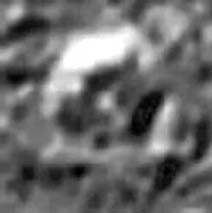
The “Geo-Dome”
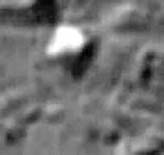
The “Pyramid.”
Slightly northwest of the “chalet” is this enigmatic faceted object. Again it is very bright and appears to have a 4-sided pyramidal structure. The direction of the shadows makes determining the details of the underside impossible, but the object does appear to be generally 4-sided and symmetrical.
This object resembles a tractor or bulldozer with a drooping scoop set off to the right. It seems to have an opening in-between the “arm” and the base of the main body. There are cavities beneath the object in shadow, separated by a “post” between them.
The “arm” seems to be made of as many as 8 individual components. The shadow indicates this is a solid vertical structure and its brightness against the background implies it is not made of the same material as the surrounding terrain.
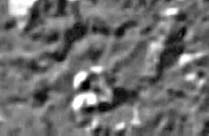
The “Backhoe”
This looks to be a basically symmetrical object with 2 central “nodes” and curved arms extending from the central body. There appears to be some underlying support just to the left of the right hand curved “arm”, but the central spherical “node” looks to be above the ground, judging by the shadow beneath it.
Note that is also sits in what appears to be an excavated “pen” or platform. I am not aware of any accepted process that could account for this object forming naturally. In an effort to understand the shape I was seeing, I rendered the object and the pen in a 3D CAD system as I saw its various pieces and components.
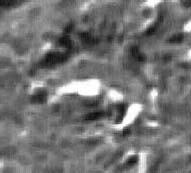
The “Longhorn.’
Each of these objects on their own could potentially be explained away by some exotic natural process. However, due to their grouping in such a small area and varying visual characteristics, it is unlikely one explanation could encompass them all. These objects all have the look of machinery or constructs, as opposed to the simple boulders and cracks which should dominate this landscape. Indeed, the very geometric complexity of these objects argues for their non-natural origin.
If we had been stuck with just the Clementine data from 18 years ago, we might never have known any more about these weird objects on Tycho’s rim than we do today. However, in 2009 NASA sent the Lunar Reconnaissance Orbiter to the Moon, with a hi-res camera better than anything that had been sent there before. They very quickly made the floor of the crater Tycho a target of this wonderful instrument, but early views showed the northeast rim in shadow and later images were of no better quality than the Clementine data. I assume much better versions of the LRO Tycho images do exist; I just haven’t been able to find them as of this writing.
As to the ones that have been publically released, well everything still seems to be there, and my earlier findings are certainly not refuted by what they show. They still stand out because of their brightness and unique visual characteristics. There still appear to be entrances into some of the objects, and the backhoe and longhorn are still just plain weird. And then there’s that pyramid looking thing…
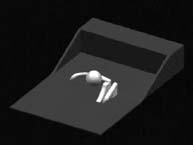
CAD recreation of the “Longhorn.”

The Tycho Village from Lunar Reconnaissance Orbiter.
I’ve always found it very curious that these objects on the northeast rim of Tycho disappeared in the spectral analysis done during the Clementine period. Perhaps only a landing—manned or otherwise—will settle their origins once and for all.
Another region of interest on the Moon that I was hoping to update was the area around the craters Hortensius and Hortensius C. Back in the late 1990s, I worked with Steve Troy on looking over the area for my old Lunar Anomalies web page. Steve had found some very interesting geometry in the area between the two craters, and had forwarded the excellent Lunar Orbiter medium resolution image to me for study.
Hortensius is an equatorial [6 degrees N, 28 degrees W] nearside, 14 km-wide crater just southwest of Copernicus. The region is dominated by a series of volcanic domes stretching several hundred miles north of the crater itself. When I originally got LO-III-123M and the sectionals from Steve I wasn’t all that excited. Sure, there were some interesting patterns and the “volcanic” domes of this area don’t look all that volcanic, but I had basically decided this would be a backburner project. Then I looked at the sectionals.
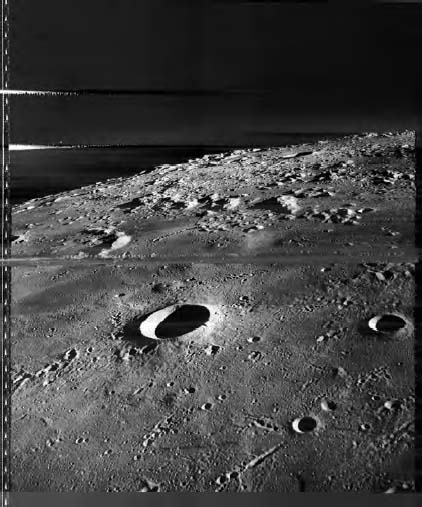
NASA frame LO-III-123M. Prominent craters in the middle of frame are Hortensius and Hortensius C.
They revealed a vast expanse of regular geometric patterning that seemed to flow in the same directions, parallel to each other all the way across the frames and crossing at very regular perpendicular angles. They were also not in line with the grain of the film and were substantial enough to be blatantly obvious with a magnifying glass. You can even note them on the highly compressed crude scan above. Volcanic fracturing can certainly cause parallel patterns, but perpendicularity over a vast (100 square kilometers) area is far harder to explain away as volcanic. In addition, the patterning seemed to be more like channels or tubes rather than a fracture pattern.
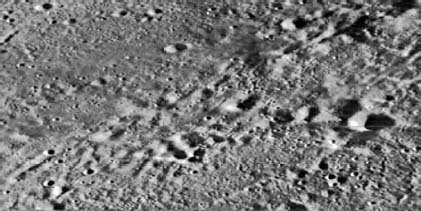
Wide angle view of complex, geometric patterning between craters Hortensius and Hortensius C.
The really weird thing though was that a lot of this pattering was
on top
of the feeble ejecta blanket around Hortensius (the big crater in the lower middle) itself, hinting that it either came
after
the formation of the crater or was only partially obliterated by the thin ejecta layer.

